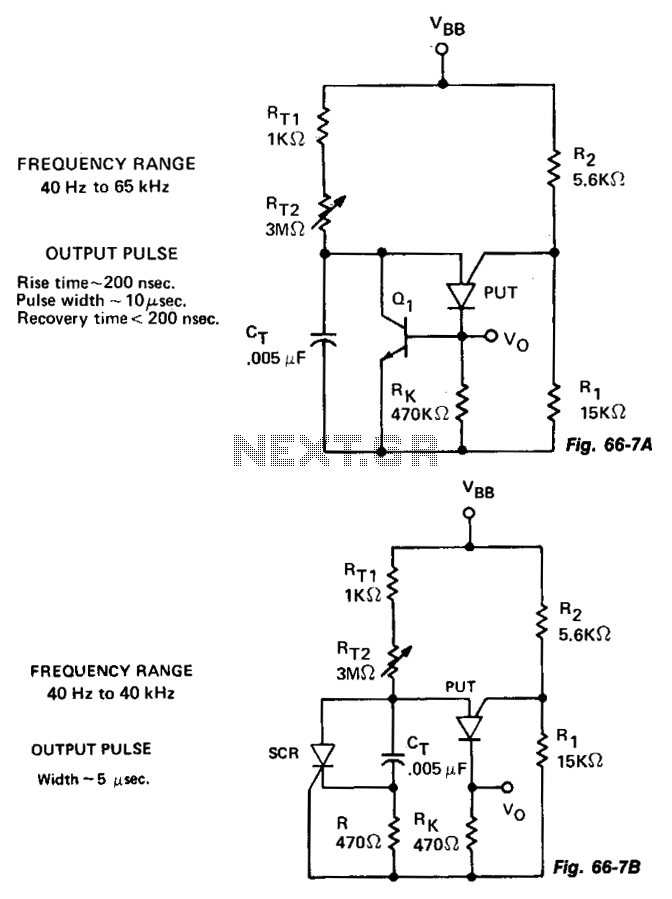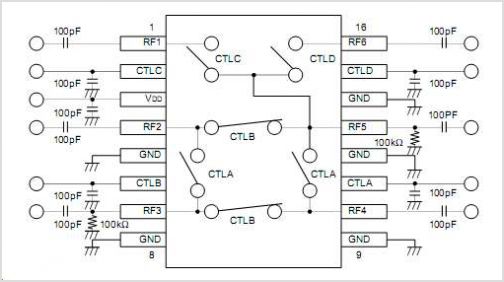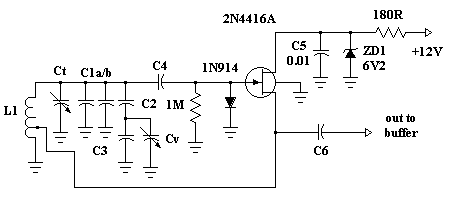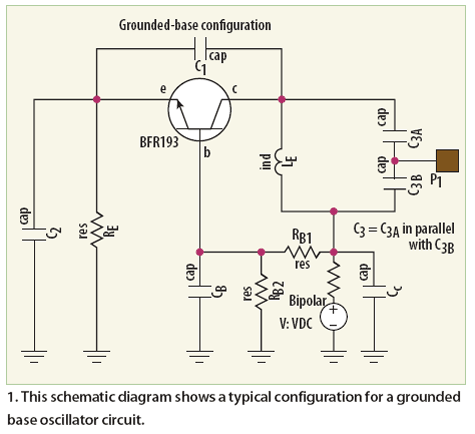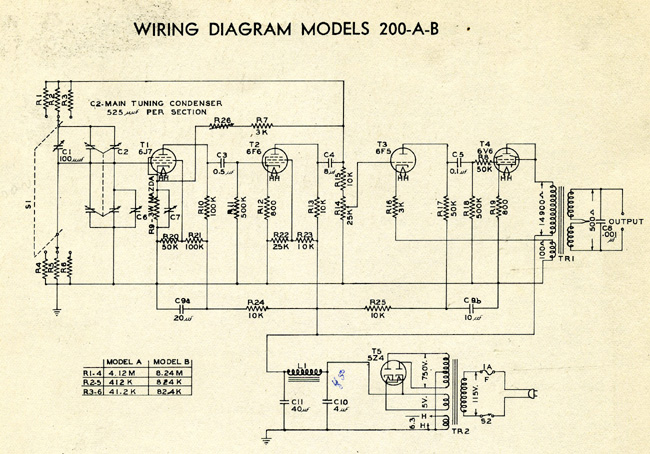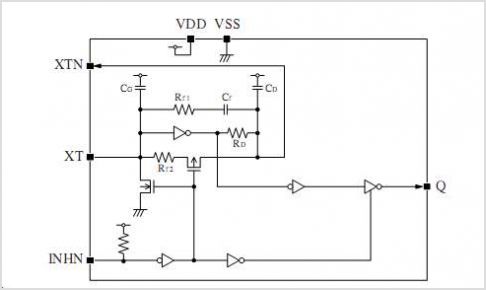
High-Frequency Oscillators
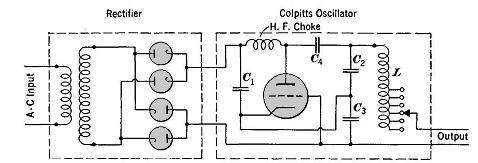
High frequencies are defined as those above 50,000 cycles per second. For industrial power supplies, the Golpitts circuit or the coupled-grid self-excited oscillator circuit is most commonly used. In either circuit, the alternating supply voltage is stepped up through a power transformer to a voltage range of approximately 7,500 to 15,000 volts, which is then rectified by a suitable bank of mercury-vapor rectifier tubes. In the Golpitts circuit, the capacitors C2 and C3 create an anti-resonant circuit with the inductance L and the load inductance, which may be an induction heating coil connected at the output terminals. The inductance L is tapped to maintain the total circuit inductance at an appropriate value for anti-resonance at the desired frequency, regardless of the heating coils used. Capacitor C4 acts as a "blocking" capacitor, preventing the flow of direct current into the resonant circuit. The high-frequency choke coil allows direct current to flow to the anode of the oscillator tube while presenting a high limiting impedance to high-frequency currents that could otherwise return to the rectifier. Capacitor C1 bypasses any high-frequency current that manages to pass through the choke back to the cathode. The voltage across capacitor C3, applied between the grid and the cathode of the oscillator tube, feeds back part of the anode output, enabling the tube to function as an amplifier and self-regenerator at the frequency determined by the constants of the anti-resonant circuit. The oscillator tube is a high-voltage vacuum tube, commonly referred to as a pliotron. In the coupled-grid self-excited oscillator circuit, the grid voltage is supplied by a feedback coil that is inductively coupled to the variable inductance L. Capacitor CR replaces capacitors C2 and C3 from the Golpitts circuit.
The Golpitts circuit and the coupled-grid self-excited oscillator circuit are essential for generating high-frequency signals in industrial applications, particularly in induction heating systems. The design allows for efficient voltage transformation and rectification, which is critical for high-voltage applications.
In the Golpitts circuit, the use of capacitors C2 and C3 in conjunction with the inductance L creates a resonant condition that maximizes the output power at the desired frequency. The careful selection of the inductance tap ensures that the circuit remains tuned, even when different heating coils are introduced, which is vital for maintaining performance consistency.
The blocking capacitor C4 plays a crucial role in isolating the resonant circuit from direct current, thereby ensuring that only alternating currents contribute to the heating process. This isolation is necessary to prevent damage to the oscillator tube and maintain stable operation.
The high-frequency choke coil is designed to allow direct current to pass while blocking high-frequency signals, effectively protecting the rectifier from potential feedback that could disrupt its operation. The feedback mechanism involving capacitor C3 is integral to the self-regenerative nature of the oscillator tube, allowing it to amplify the signal and sustain oscillations without external input.
In the coupled-grid self-excited oscillator circuit, the feedback coil's inductive coupling to the variable inductance L provides a means of fine-tuning the oscillator's frequency response, allowing for adjustments based on the specific requirements of the application. This adaptability is essential in industrial settings where different heating requirements may arise.
Overall, both circuits exemplify advanced techniques in high-frequency signal generation and rectification, showcasing the intricate balance of components that enable efficient operation in demanding industrial environments.High frequencies are here defined as those above 50, 000 cycles per second. For industrial power supply the Golpitts circuit, Fig. 28-1, or the coupled-grid self-excited oscillator circuit, Fig. 28-2, is most commonly used. In either circuit, the alternating supply voltage is stepped up through a power transformer to some voltage between about 7500 and 15, 000 volts and is then rectified by a suitable bank of mercury -vapor rectifier tubes. In Fig. 28-1 the condensers C2 and C3 form an anti-resonant circuit with L and the inductance of the load which may be an induction heating coil fed at the output terminals. The inductance L is tapped so that, even though different heating coils may be used, the total inductance of the circuit can be kept at proper value for anti-resonance at the desired frequency.
Condenser C4 is a "blocking" condenser and prevents the flow of direct current into the resonant circuit. The high-frequency choke coil passes the direct current to the anode of the oscillator tube, but presents a high limiting impedance to the high-frequency currents which would otherwise flow back into the rectifier.
The condenser C1 by-passes back to the cathode any high-frequency current which does pass through the choke. The voltage across condenser C3, being applied between the grid and the cathode of the oscillator tube, feeds back part of the tube`s anode output, and so causes the tube to be an amplifier and hence a self-regenerator at the frequency established by the constants of the anti-resonant circuit.
The oscillator tube is a high-voltage vacuum tube sometimes known as a pliotron. In Fig. 28-2 the grid voltage is supplied by a feed-back coil inductively coupled to the variable inductance L. The condenser CR replaces the condensers Cz and C3 of Fig. 28-1. 🔗 External reference
The Golpitts circuit and the coupled-grid self-excited oscillator circuit are essential for generating high-frequency signals in industrial applications, particularly in induction heating systems. The design allows for efficient voltage transformation and rectification, which is critical for high-voltage applications.
In the Golpitts circuit, the use of capacitors C2 and C3 in conjunction with the inductance L creates a resonant condition that maximizes the output power at the desired frequency. The careful selection of the inductance tap ensures that the circuit remains tuned, even when different heating coils are introduced, which is vital for maintaining performance consistency.
The blocking capacitor C4 plays a crucial role in isolating the resonant circuit from direct current, thereby ensuring that only alternating currents contribute to the heating process. This isolation is necessary to prevent damage to the oscillator tube and maintain stable operation.
The high-frequency choke coil is designed to allow direct current to pass while blocking high-frequency signals, effectively protecting the rectifier from potential feedback that could disrupt its operation. The feedback mechanism involving capacitor C3 is integral to the self-regenerative nature of the oscillator tube, allowing it to amplify the signal and sustain oscillations without external input.
In the coupled-grid self-excited oscillator circuit, the feedback coil's inductive coupling to the variable inductance L provides a means of fine-tuning the oscillator's frequency response, allowing for adjustments based on the specific requirements of the application. This adaptability is essential in industrial settings where different heating requirements may arise.
Overall, both circuits exemplify advanced techniques in high-frequency signal generation and rectification, showcasing the intricate balance of components that enable efficient operation in demanding industrial environments.High frequencies are here defined as those above 50, 000 cycles per second. For industrial power supply the Golpitts circuit, Fig. 28-1, or the coupled-grid self-excited oscillator circuit, Fig. 28-2, is most commonly used. In either circuit, the alternating supply voltage is stepped up through a power transformer to some voltage between about 7500 and 15, 000 volts and is then rectified by a suitable bank of mercury -vapor rectifier tubes. In Fig. 28-1 the condensers C2 and C3 form an anti-resonant circuit with L and the inductance of the load which may be an induction heating coil fed at the output terminals. The inductance L is tapped so that, even though different heating coils may be used, the total inductance of the circuit can be kept at proper value for anti-resonance at the desired frequency.
Condenser C4 is a "blocking" condenser and prevents the flow of direct current into the resonant circuit. The high-frequency choke coil passes the direct current to the anode of the oscillator tube, but presents a high limiting impedance to the high-frequency currents which would otherwise flow back into the rectifier.
The condenser C1 by-passes back to the cathode any high-frequency current which does pass through the choke. The voltage across condenser C3, being applied between the grid and the cathode of the oscillator tube, feeds back part of the tube`s anode output, and so causes the tube to be an amplifier and hence a self-regenerator at the frequency established by the constants of the anti-resonant circuit.
The oscillator tube is a high-voltage vacuum tube sometimes known as a pliotron. In Fig. 28-2 the grid voltage is supplied by a feed-back coil inductively coupled to the variable inductance L. The condenser CR replaces the condensers Cz and C3 of Fig. 28-1. 🔗 External reference
